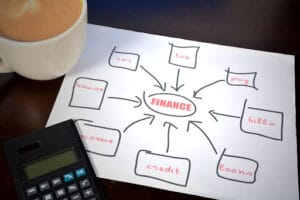A personal financial plan can be the key to a more secure and prosperous future. It allows you to find new ways to increase your wealth and take care of your finances better.
In this article, we’ll discuss how to make a comprehensive personal finance plan so that you can protect yourself against life’s surprises. So, let’s get started.
What is a Personal Finance Plan?
In a nutshell, a personal financial plan is a roadmap or a documented analysis of your personal finances. It includes everything from your income, investments, and savings to assets and liabilities.
It takes into account your current financial goals and situation and provides you with a detailed strategy to prioritize your objectives. It provides you with financial freedom and helps you understand when to save money and when to spend it.
Additionally, a personal financial plan also allows you to prepare yourself for unexpected situations such as an economic downturn, illness, or job loss.
How to Make a Personal Finance Plan
If you want to make a comprehensive personal finance plan to manage your finances better and prepare for the future, consider using the tips listed below.
Understand the Flow of Your Money
The first step is to understand the flow of your money thoroughly. You should know how much money you earn and spend each month.
First, you need to take your income into account. Keep in mind that it isn’t just about your salary. You need to consider everything that generates money for you. It includes any property rental income, career allowance, child benefit, cash gifts, interest on savings, and even money earned through selling things online.
After that, you’ll need to make a list of all your monthly expenses. You can use your bank statements for this purpose. Your main expenses will include insurance, travel costs, groceries, utilities, entertainment, and shopping.
After creating these two lists, you’ll need to subtract your expenses from your income to see whether you have money left over or a shortfall of money. You’ll need to reduce your expenses if you’re spending more than your total income.
Set Your Financial Goals
Setting clear financial goals provides you with clarity when you’re making your financial decisions. They’ll help you determine whether you’re moving in the right direction or not. Ideally, your financial goals should be specific, measurable, attainable, relevant, and time-bound.
Your financial goals shouldn’t just say that you want more money in your savings account. You’ll need to define how much money you must save in a specific amount of time. Plus, you should also write down the reason why you need to save money.
For example, you can set a goal that “I will save $5,000 within 12 months to buy a new car. Not only will it give you a clear idea about how much money you need to save each month but it’ll also help you stay motivated to achieve your financial goals.
Set a Monthly Budget
Once you know the flow of money in and out of your bank account and have set clear financial goals, the next step is to plan out a detailed monthly budget. There are different budget strategies that you can use for this purpose.
One of the most popular and effective strategies is the 50/30/20 rule. According to this strategy, you’ll need to divide your monthly income into three parts. The first part will consist of 50 percent of your total income and it’ll be used for basic necessities such as food, utility bills, and minimum debt payments.
The second part will consist of 30 percent of your income, which will be used for your wants such as entertainment and shopping. Lastly, the 20 percent part will be used for saving money.
It’s important to note that it’s just one of the many budgeting strategies. You can use the one that suits you the best. The purpose of budgeting is to spend money wisely and save something every month from your income.
Open Savings Accounts
Saving money must be a part of your personal financial plan. One of the best ways to save money is to open a high-yield savings account where you can store your funds. It will increase the amount of money you have in the account based on the interest rate.
You can open multiple savings accounts for different financial goals if you want. Additionally, you can also set up monthly transfers from your checking account so that they can automatically reach your savings account.
Create a Plan for Debts
If you want to be financially stable, you should have a detailed plan to manage your debts. If your repayments and interests are weighing you down continuously, you won’t be able to meet your short and long-term financial goals.
The aim of this plan is to help you get rid of all your debts as soon as possible. Keep in mind that debts include everything from student debt, car loans, mortgages, and even credit card debt.
Create an Emergency Account
Creating a designated savings account just for the emergency fund will work as a financial safety net for you. No matter how much money you have and how well-prepared you are, there can be an unexpected situation that will cost you a whole lot of money.
In such a situation your savings account with an emergency fund will come to the rescue. It’ll help you take care of difficult situations such as losing a job, an unexpected illness or accident, or even an outstanding bill that you forgot.
While everyone should have a designated account for an emergency fund, you’ll need it the most if your income is variable.
Don’t Forget about Insurance
Having the right insurance will help you avoid using your savings each time an unexpected situation pops up. For example, you must have your home insured to cover the cost that you’ll need to spend in case of a natural disaster.
You should also have car insurance so that you can get it fixed easily without breaking the bank if something goes wrong with it. Insurances will help you achieve your financial and savings goals even when you’re going through a hard time financially.
Secure Your Future
The last and one of the most important parts of a personal financial plan is to secure your future. It’s about making investments and focusing on your savings.
Opening up a retirement account and filling it with retirement savings is an excellent way to make sure that you’ll be ready financially to deal with your future. Answer the following questions when you’re planning for retirement to secure your future.
- What is your desired age for retirement? (You must be realistic here)
- What type of lifestyle you’re planning to have when you retire?
- What is your current health status? If you have health issues, you’ll need more money to tackle them.
- What is your current rate of savings?
You can also start investing and talk to your financial advisor to use investment accounts to save money for the future.
Final Words
Creating a personal financial plan is one of the best things that you can do to manage your finances and you must never underestimate its importance. It’ll help you improve your spending and saving habits and allow you to get prepared for all types of financial situations.
We hope this guide will help you understand how to make a personal financial plan for better money management and to achieve your financial goals.



